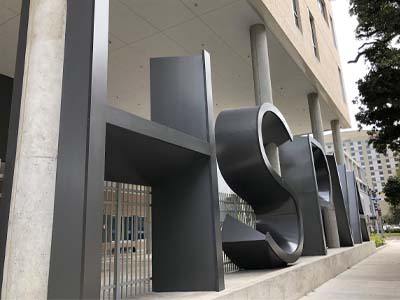When your business has the opportunity to construct or renovate a building from the ground up, it’s essential that the facility is both visually appealing and functional. An excellent way to accomplish this goal is by incorporating architectural signage into the overall construction plans.
Discover the purpose of architectural signage design, the ways it improves your commercial property, and how National Signs can provide stunning sign solutions that are both practical and captivating.
What is Architectural Signage?
Businesses rely on several different types of property signage, such as changeable signs in lobbies or office entrances, installed signs inside and outside the building, and temporary signs for upcoming events or promotions.
Architectural signage is more than just a single sign – it’s a permanent sign system installed throughout a public or commercial property with the purpose of improving the visitor experience.
Architectural signs are custom designed to perfectly reflect a business’s brand and aesthetic while weaving in wayfinding functions throughout the building or campus. They communicate navigational information to guests and employees in a clear and concise way without diminishing the building’s style or purpose.
Examples of architectural signage include:
- Directional signs
- Digital signage
- Video walls
- Large-scale 3-D signage
- Monument signs
- Illuminated signage
- Channel letters
Because of their importance to your business and your visitors, architectural signage design should be included in the very beginning stages of your building’s construction plans to offer a cohesive flow across the property.
The Four Benefits of Architectural Signage Design
Architectural signage provides four distinct benefits to a commercial building or campus, especially when it’s included early in the construction plans of the property.
1. Brand Enhancement
When done right, architectural signs function together to display key information in a unified way that complements a business and its brand. Signage can perfectly match a company’s style and décor, whether bold and eye-catching, sleek and modern, or minimal and classic.
With architectural signage, you gain the ability to transform ordinary signs by incorporating different styles and artistic flourishes, which elevates the entire property. Visitors are more likely to notice visually appealing signs and walk away with a positive impression of the property.
Instead of a standard lobby sign with a business name, opt for large-scale 3-D letters that use shadows and light for a greater impact. The school campus or healthcare facility can use dynamic and engaging digital screens to display a rotation of important information and graphics.
2. Simplifies Building Navigation
Wayfinding signs don’t have to be complicated or over-the-top to make an impact. In fact, developing an effective wayfinding signage system will often result in simple, straightforward building navigation that helps people get where they need to be in an efficient manner.
Architectural signs make the biggest impression on large campuses or facilities where visitors depend on good, clear navigation to help them find their way. Industries that benefit most from architectural signage design include:
- Hospitals
- Colleges and universities
- Stadiums and athletic arenas
- High-rise office buildings
- Hotels
- Large shopping malls
- Performance venues
Incorporating clear and engaging signage into the building plans helps create a professional appearance while making it easier for visitors and employees to navigate the property.
3. Meets ADA Compliance
Many public buildings and spaces are required to display navigational and building signs that are in compliance with the Americans with Disabilities Act, known as the ADA.
Restaurants, grocery stores, retailers, schools, banks, hotels, and other public facilities must display signs that meet specific ADA guidelines for sign size, placement, color, font, pictograms and symbols, and Braille typography.
ADA-compliant signage should be installed throughout the property to identify:
- Building entrances or exits
- Restrooms
- Stairway or elevator access
- Emergency exits
- Rooms, offices, or departments
- Conference halls
- Parking areas
When you integrate architectural signage design into the original construction plans, you can organically include ADA-compliant signs in required areas to ensure the facility is welcoming and accessible to everyone who enters.
4. Offers Durability
Unlike temporary banners or signs, custom architectural signage offers longevity and visual appeal for years to come. The commercial property will benefit from professionally designed and manufactured signage constructed of durable materials such as:
- Metal
- Stone
- Acrylic panels
- Glass
- Digital screens
- Video walls
Property signage is an important investment, so you need signs that will be able to captivate and inform while also maintaining long-term functionality.
National Signs Offers Architectural Signage Design
With over 30 years of experience providing exceptional sign solutions to industries across the country, National Signs is ready to help you elevate the construction of a commercial property with exceptional architectural signage design solutions.
Our team specializes in creating custom sign designs that are eye-catching, practical, and cost-effective. We take the time to understand the specific needs and goals of our clients. Then, we deliver dynamic sign solutions that support building spaces and property exteriors.
View our gallery to discover the different types of architectural signage we support. Or, contact us directly to learn more about our full range of design options for architectural accents.




